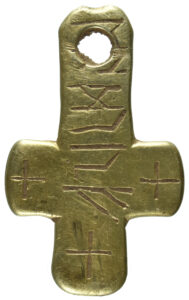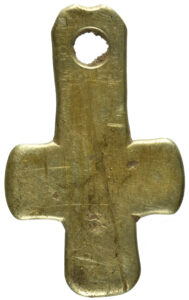A gold cross pendant discovered near Berwick-upon-Tweed in Northumberland, England, is inscribed with the previously unknown Anglo-Saxon name “Eadruf.” The solid gold cross is of a simple Latin form with the longest arm at the top. It is an inch long and .6 inches wide on the crossbar. Runes were incised down the length of the arm to just past crossbar. The foot of the cross and the horizontal arms are inscribed with equal-armed crosses. It is perforated at the apex and the crude hole filed to smooth some of its rough edges, but this was done after the runes were carved, likely after its original top-mounted loop was lost so it was modified to be suspended from a hole instead. It dates to between 700 and 900 A.D.
The pendant was found last year by a metal detectorist on the banks of the River Tweed. There are very few comparable examples. Most early Anglo-Saxon crosses are equal armed, and none have been found before with runic inscriptions.
When the finder reported it the Portable Antiquities Scheme, they consulted several specialists were enlisted to examine the cross and translate the inscription.
From the report by Professor John Hines of Cardiff University:
It seems likely from the width and shape of the cuts that the three incised crosses at the ‘head’ end of the shaft and in either arm were cut at the same time as the runes. Six runes can be identified, reading left to right from the ‘foot’ of the shaft, with the first two drilled through by the wide perforation. […]
Artefacts such as this are quite often inscribed with the personal name of a person with whom the object had been associated (usually to be assumed as the possessor, if nothing else is indicated). Old English personal names beginning Ead- (‘happiness’, ‘fortune’) are common, but the only two known with a second element beginning r- are Eadred and Eadric. No personal-name element ruf can be identified in any Germanic language, and Eadruf would therefore be a hitherto unknown and etymologically mysterious name.
The findspot is also mysterious, in that there are no archaeological remains of an early medieval settlement in the area. At the time the pendant was made, the Tweedmouth area was part of a group of holdings belonging to the Holy Island of Lindisfarne, but while there are records indicating a church or abbey may have been in the vicinity, there is zero archaeological evidence of any structure from the early Middle Ages. Artifacts have been thin on the ground too. Other than this cross, the only other object from Anglo-Saxon period found here is a late 10th century copper-alloy strap fitting.

